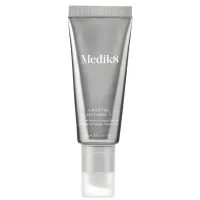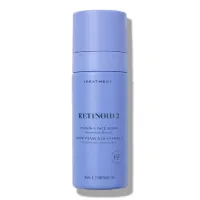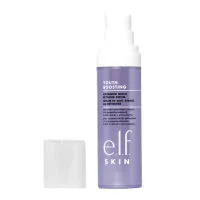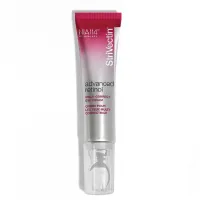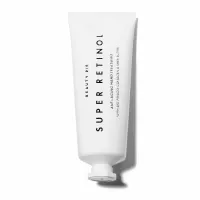What does retinol do for your skin? Benefits, side effects and how to use it
What to know about this wonder ingredient

Ever wondered what does retinol do for your skin? You're not alone.
Retinol is a word that tends to incite either excitement or confusion depending on who you’re chatting to. Sometimes, it’s both. But is it really worth the hype? A lot of the doubts around retinol stems from the fact that it tends to be used as an umbrella term for the family of ingredients it’s part of called retinoids.
“Retinoids are all derivatives of vitamin A, and the difference between them relates to their molecular structure,” says Dr Jo Mennie, Aesthetic Practitioner at Dr David Jack Clinic and Get Harley. “They can all stimulate the skin very differently, with different efficacy and even different side effects,” adds Dr Tiina Meder, Cosmetic Dermatologist at Get Harley and Founder of Meder. Some of the most common side effects of Retoinoids are dry, peeling skin, so make sure you've loaded up on the best moisturisers for skin to soften and soothe.
Retinol vs Retinoid: What's the difference?
Think of retinoids like apples. Apples are the category, just like retinoids, and there are different types within them. The types of retinoids include retinoic acid, retinal, retinol and retinol esters, just like types of apples include Granny Smith, Braeburn and Pink Lady.
Retinoic acid is the strongest of all forms of retinoid. It’s high-strength and is only available via prescription. It’s punchy and can lead to dryness and flaking. It was traditionally (and still is) used to treat acne and get rid of acne scars, but experts started to notice improvements in lines and wrinkles as a welcome bonus.
All other forms of retinoids are considered to be cosmetic ingredients and can be purchased without a prescription. The closest to retinoic acid is retinaldehyde (also called retinal), which converts back to retinoic acid in the skin in one step. It works fast, shouldn’t cause irritation and has antibacterial properties too. Next is retinol, which is two steps away from retinoic acid and therefore converts twice on the skin before it gets there. It’s effective but is known to cause irritation. Finally, there are retinyl esters like retinyl palmitate. These are retinoids mixed with another ingredient, which makes them weaker and a good starting point for beginners.
Slightly confusingly, there is also a newer form of retinoid which sits slightly outside the hierarchy we’ve just outlined. These are retinoic acid esters (not to be confused with retinol esters) and work differently from the others as they bind directly to receptors in the skin instead of converting to retinoic acid.
Parenting advice, hot topics, best buys and family finance tips delivered straight to your inbox.
What does retinol do for your skin?
Retinol will more than earn its place in your bathroom cabinet with a number of benefits for the skin, most notably preventing wrinkles.
“When applied to the skin, retinol is converted to retinoic acid, the molecule that signals skin cells to produce proteins such as collagen,” Daniel Issacs, Director of Research at Medki8. “This increase in retinoic acid both boosts and preserves collagen levels within the skin for a plump, youthful complexion.”
This is especially welcome as we age, as the levels of collagen in our skin start to deplete from the ages of 20-30. Without this important scaffolding to give our skin bounce, it can become slack with fine lines and wrinkles forming.
“Vitamin A can also boost the regenerative cycle of skin cells and hinder the formation of excess melanin to leave skin looking smooth and even-toned,” Daniel continues. An uneven complexion peppered with age spots can be one of the biggest giveaways of your age, but by speeding up the rate at which your skin rids itself of old, redundant cells, you can make any marks scarce faster. This makes it a great, straightforward treatment if you're wondering how to get rid of liver spots and pigmentation.
The increase in cell turnover also has an impact on blemishes. Spots form when old skin cells and oil block a pore. So, with these dead skin cells no longer hanging around and outstaying their welcome, the chances of clogged pores are far lower. Simply put, using retinol is like rebooting your complexion.
A post shared by its ana (@anastipsorwhatever)
A photo posted by on
What are the benefits of Retinol?
- Smoothes and brightens skin. Our skin is always busy behind the scenes replacing the older skin cells on the surface of our complexion with the shiny new ones beneath. As we age, this process no longer happens quite as efficiently – a bit like a merry-go-round that’s slowing. Retinol speeds the process back up, so skin looks glowier and feels softer.
- Reduce the appearance of fine lines and wrinkles. By encouraging the skin to create more collagen, retinol plumps fine lines and wrinkles. Skin becomes bouncier and less slack.
- Fade hyperpigmentation. By whisking away old, marked skin cells, retinol can reduce the appearance of dark marks like sun spots and post-inflammatory hyperpigmentation (blemishes left behind by spots).
- Banish blemishes and congestion. Removing old skin cells from the equation means pores are less likely to become clogged. Retinal also boasts antibacterial properties.
What are the negative side effects of retinol?
There are three side effects you may experience when using retinol - initial irritation, a break-out of spots and increased sensitivity to sunlight.
Heard a rumour that retinol can give you red and flaky skin? There is truth in the murmurings. “When you start using retinoids there is a 4-week period of adjustment that the skin goes through,” says Jo. “This process is called Retinization. What that translates as is the potential for redness, feelings of tingling or itching on the skin, or dryness and scaling.”
The good news is that firstly, it shouldn’t last for too long, and secondly, this won’t happen to everyone that uses retinol. Everyone’s skin is different, and how it reacts will depend on things like your skin type and age. Equally, the weaker the retinoid product you use, the less chance of your skin throwing a hissy fit.
The phrase is problematic, but the term skin purging is used to describe occasions when your skin breaks out as a result of starting to use a new ingredient (like retinol). “Some users can experience a purging when introducing new active ingredients into their routine,” explains Daniel. “This can be common with retinoids as they increase skin cell turnover. This increase can cause debris trapped deep in existing clogged pores to quickly rise to the surface and appear as new spots.”
So far, not so ideal – but wait for it. “Purging is actually a good thing,” continues Daniel, “as it shows that your skin cells are regenerating quicker, pushing out any congestion and ultimately leading to a smoother-looking, blemish-free complexion in the long run. A purge is temporary but can last up to 6-8 weeks.”
If the potential for breakouts is putting you off the idea of retinol, don’t let it. Remember, retinoic acid was originally used in the treatment of acne, and retinal has antibacterial properties which make it great for blemish-busting. Going slow will help keep the potential for breakouts to a minimum. “To reduce the chances of purging, we recommend phasing new products into regimes slowly,” adds Daniel.

When our skin is exposed to the sun, it creates extra melanin (the pigment that gives our skin its colour) as a sort of natural protection. It’s essentially why you get a tan. The problem comes when the skin malfunctions and makes more melanin than is needed, resulting in darker patches like age spots. And the laxer you are about sun protection, the more likely these are to form.
Add retinol to the mix, and the risk rises even higher. “Retinol and its derivatives are known photo sensitisers able to increase the sun’s sensitivity to ultraviolet rays,” says Tiina. “After a few weeks of use, skin can become prone to hyperpigmentation. If you are using retinol-based products it is a good idea to increase sun protection to the absolute maximum and use 50+ sunscreens with UVA protection every time you go outdoors, no matter how much time you’re spending in the sun.”
Stock up on the best sunscreen for your face, and get diligent about applying in the morning and re-applying.
How do you know if retinol is working?
Patience really is a virtue when it comes to waiting for your retinol to work, but you could see positive results within 3-6 months of using it.
“Any skincare product takes time to see the effects,” says Dr Jo. “With retinol in the first month, you may experience sensitivity or dryness. However, by 6 months you should be able to see visible improvements in the skin’s appearance.”
That’s not to say you might not see results before then, but don’t be disheartened if you’re not spotting changes by the end of week one.
Interestingly though, Dr Tiina Meder makes a case for not continuing to use retinol once you’re seeing results. “Be ready for a long course of treatment, but not too long,” she advises. “Researchers found that retinol acids progressively and you can see positive effects in 18-20 weeks of use. But it doesn’t improve results after weeks 20 and 21, and instead could even provoke more side effects because of the prolonged use.”
Just be sure to check in with your skin regularly, and if it’s not looking or feeling good, and your skincare no longer seems to be performing, then make a change.
How to start using a Retinol:- Use in your PM routine only-Start ONCE weekly for a minimum of 6 weeks.-NEVER USE ON A DAMAGED BARRIER -Accompany with frequent SPF application (AM only)- Hydrate Hydrate Hydrate!March 11, 2021
How to use retinol
1. Only use at night
Retinol works best at night for a couple of key reasons. Firstly, it’s the vampire of the skincare sphere and doesn’t take well to being exposed to light.
“Most retinoids cannot be used in the day as they are not photostable,” says Daniel Issacs. “This means that their effects will be deactivated when exposed to sunlight.”
This is why you'll often find the ingredient in the best night cream. The second reason is that by using retinol as an evening-only product you're giving it the maximum opportunity to work its magic without interruption. It will be able to work more efficiently if it’s not under siege from daytime stressors like pollution.
2. Apply to clean skin
Cleansing is the bedrock of any good skincare routine. So, if you’re not washing your face properly then anything you apply afterwards is ultimately a waste of time.
Your retinol won’t be able to penetrate the skin as effectively if it has to battle through a barrage of daily grime in order to get there. Skin should be dry, not damp, too.
“It’s always better to apply retinol-based products to dry skin and avoid layering with water-based products,” advises Tiina. “This helps to minimise irritation and sensitisation.”
3. Pare back other active ingredients
You may want to step away from your best Vitamin C serum while you're introducing in retinol. Not all active ingredients play nicely with retinol, and mixing the wrong cocktail of actives can at best cancel out any benefits, and at worst lead to irritation.
That means unless your skin is very hardy, and you’re a long-time user of retinol, exfoliating acids are temporarily off the menu. “Combining retinol-based products with acid-based products is a bad idea,” explains Tiina. “Both ingredients are powerful and speed up the skin renewal process, so can irritate the skin and would be damaging for the skin barrier.”
If you can’t quite part with your alpha or beta-hydroxy acids, consider using them on alternating days to your retinol. This way you’ll be able to reap the benefits of both without vexing your complexion.
4. Use SPF the next day
“Be sure to use sunscreen all the time while using retinol-based products, because retinol increases skin sensitivity to ultraviolet rays,” says Dr Tiina Meder. This is because retinol has brought all of that lovely new skin to the surface, which is more susceptible to damage and hyperpigmentation.
The SPF in your makeup won’t be enough to properly protect your skin and you should really be using a dedicated sunscreen of at least SPF30.
5. Introduce slowly
Throwing the kitchen sink at your complexion is never a good idea. To get the most from your retinol product, ease in rather than diving in.
“Baby steps are a good idea when you’re starting,” says Dr Tiina. “Use a small amount once a day and start with the application just three days a week.” From there, if your skin is happy and tolerating the retinol well, you can start to slowly increase to everyday use.
Our top retinol picks
Medik8 Crystal Retinal 1 Stable Retinal Night Serum Vitamin A | RRP: £45
If you want to take a considered approach to using retinol, Medik8 have the perfect solution. Their Crystal Retinal comes in varying strengths, starting from 1 (which is best for very sensitive skin) and building to 20 (for highly experienced users). It’s a little confusing, but the numbers are indications of the potency of the product and not the percentage.
Skin Rocks Retinoid 2 Vitamin A Face Serum | RRP: £75
Already a fan of retinoids? Jump in at the deep end with Skin Rocks’ advanced serum. It contains retinal and hydroxy-pinacolone retinoate and works to smooth and brighten skin that needs a bit of a reboot.
Elf Youth Boosting Advanced Night Retinoid Serum | RRP: £22
Looking for an affordable retinoid? This is formulated with retinal, which works faster in the skin than retinol and with less chance of irritation. The texture is balm-like and feels nice and nourishing on the skin.
StriVectin Advanced Retinol Multi-Correct Eye Cream | RRP: £68
Retinol isn’t normally recommended for the eye area unless it’s been specially formulated for it – like in this cream. It has proven results on smoothness, firmness and elasticity, which is especially welcome on crow’s feet and sagging upper eyes.
Beauty Pie Super Retinol Anti-Aging Hand Treatment | RRP: £12.50 for members
We pay a lot of attention to our faces, but our hands are often neglected. Which is a shame, especially when they’re also exposed to just as much sunshine and as many external stressors. Luckily Beauty Pie has stepped up to the plate, with an anti-ageing overnight hand cream designed to brighten and re-elasticise skin while you snooze.
Is it good to use retinol every day?
Cosmetic ingredients like retinol rely on regular and consistent use to see results, but that doesn’t mean you need to use them every single day.
“This really depends on you as an individual, which is why consultation with a doctor during your retinol journey is helpful,” explains Jo. “For some people, everyday retinol use can work well for their skin, while for others I have recommended regimes including it every other day to once a week.
"The best advice is to start slow. Build up gradually starting once a week and moving up in frequency every few weeks. If you experience irritation, dryness or scaly patches then cut back on the frequency.”
Think of it like doing Couch to 5k. If you decide to run the entire distance on day one it’s going to be a much less comfortable experience than if you built up following the programme. Equally, not everyone wants or needs to exercise every day to keep their body healthy.
Should you moisturise after using retinol?
Yes, you should always follow your retinol application with some mosituriser - no matter your skin type. This is because it helps to keep the skin hydrated.
“Moisturiser should be incorporated into your routine when using retinoids, owing to the potential for the skin to become dry,” says Dr Jo Mennie. “People with particularly sensitive or dry skin can even apply their moisturiser before their retinoid product.” This will create a bit of a buffer, and you could even go a step further and apply moisturiser on top too – like a retinol sandwich.
If you’re at the opposite end of the skin spectrum with oily skin or don’t like the feeling of too many products on your skin, Dr Jo has an alternative for that too. “Wait 20 minutes after your retinol product and apply your night moisturiser of choice,” she advises.
We spoke to the following beauty experts:

Daniel Isaacs studied chemistry at the University of Leeds before joining Medik8 more than 10 years ago. His first role was as a Product Formulator before rising up the ranks to Director of Research.
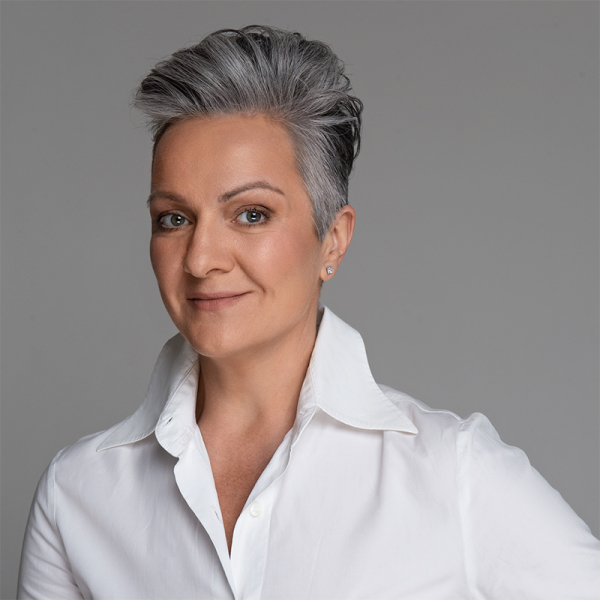
Dr Tiina Meder began her medical career in 1995 working as a cardiologist before switching to specialise in dermatology. She launched her own brand, Meder Beauty, in 2009, which focuses on using innovative ingredients to support the skin's microbiome.

Dr Jo Mennie is a Plastic Surgery Specialist Registrar with more than 11 years experience working in the NHS. She has completed a PhD in Women's Health and currently works as an Aesthetic Practitioner at Dr David Jack Clinic and online service Get Harley.
Video of the Week
